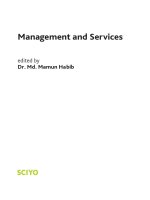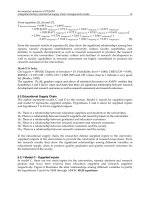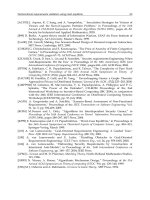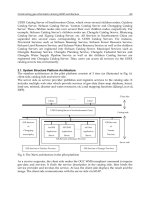Management and Services Part 1 docx
Bạn đang xem bản rút gọn của tài liệu. Xem và tải ngay bản đầy đủ của tài liệu tại đây (226.44 KB, 10 trang )
Management and Services
edited by
Dr. Md. Mamun Habib
SCIYO
Management and Services
Edited by Dr. Md. Mamun Habib
Published by Sciyo
Janeza Trdine 9, 51000 Rijeka, Croatia
Copyright © 2010 Sciyo
All chapters are Open Access articles distributed under the Creative Commons Non Commercial Share
Alike Attribution 3.0 license, which permits to copy, distribute, transmit, and adapt the work in any
medium, so long as the original work is properly cited. After this work has been published by Sciyo,
authors have the right to republish it, in whole or part, in any publication of which they are the author,
and to make other personal use of the work. Any republication, referencing or personal use of the work
must explicitly identify the original source.
Statements and opinions expressed in the chapters are these of the individual contributors and
not necessarily those of the editors or publisher. No responsibility is accepted for the accuracy of
information contained in the published articles. The publisher assumes no responsibility for any
damage or injury to persons or property arising out of the use of any materials, instructions, methods
or ideas contained in the book.
Publishing Process Manager Ana Nikolic
Technical Editor Martina Peric
Cover Designer Martina Sirotic
Image Copyright Steve Cukrov, 2010. Used under license from Shutterstock.com
First published September 2010
Printed in India
A free online edition of this book is available at www.sciyo.com
Additional hard copies can be obtained from
Management and Services, Edited by Dr. Md. Mamun Habib
p. cm.
ISBN 978-953-307-118-3
SCIYO.COM
WHERE KNOWLEDGE IS FREE
free online editions of Sciyo
Books, Journals and Videos can
be found at www.sciyo.com
Chapter 1
Chapter 2
Chapter 3
Chapter 4
Chapter 5
Preface VII
An empirical research of ITESCM
(integrated tertiary educational supply chain management) model 1
Dr. Md. Mamun Habib
Learning 2.0:
collaborative technologies reshaping learning pathways 25
Popovici Veronica
Nonfunctional requirements validation using nash equilibria 41
Vicky Papadopoulou and Andreas Gregoriades
Constructing geo-information sharing GRID architecture 55
Qiang Liu and Boyan Cheng
Realization of lowpass
and bandpass leapfrog filters using OAs and CCCIIs 73
Xi Yanhui and Peng Hui
Contents
Management in all business areas and organisational activities are the acts of getting people
together to accomplish desired goals and objectives. Service is intangible, therefore, it is not
too easy to dene the theory application in varieties of service industries. Service Management
usually incorporates automated systems along with skilled labour; it also provides service
development. Due to enormous demand of service industries and management development,
the Book entitled “Management and Services” would create a milestone in management arena
for all categories of readers including Business Administration, Engineering and Architecture.
This book covers educational service development, service-oriented-architecture and case
research analysis, including theory application in network security, GRID technology,
integrated circuit application.
This book is comprised of ve chapters and has been divided into two parts. Part A contains
chapters on service development in educational institutions. This part depicts the application
of supply chain management concept in service industries like tertiary educational institutions
and multiple ways of web 2.0 applications transforming learning patterns and pathways.
To understand the subject in a practical manner, Part B of this book consists of noteworthy
case studies and research papers on management and services. This part represents theory
application of Data mining, Fuzzy Cluster, Game theory, GRID Technology, simulation of
Operational Amplier and Current Controlled Conveyor II in network security, architecture,
and integrated circuit application. This section will certainly unveil a wide variety related to
management and services.
Chapter 1 describes an empirical study that addresses the education supply chain, the
research supply chain, and educational management as major constituents in an Integrated
Tertiary Educational Supply Chain Management (ITESCM) model. This chapter highlights
conceptual framework, model evaluation by Structural Equation Modeling technique
through AMOS, the latest statistical tool. The ITESCM model furnishes stakeholders of the
supply chain with appropriate strategies to review and appraise their performance toward
fulllment of ultimate goals, i.e. producing high-caliber graduates and high-impact research
outcomes, which represent two main contributions, for the betterment of the society. Finally,
the author recties application guidelines based on the research ndings for current university
administrators and prospective investors.
In Chapter 2, Web 2.0, a service-oriented-architecture, describes the evolving use of the
internet as a technology platform to enhance functionality, communication and collaboration.
The multiple ways of web 2.0 applications are transforming learning patterns and pathways,
or more exactly, all the advantages, opportunities and challenges for learning in educational
institutions.
Preface
VIII
The method presented in the Chapter 3 constitutes a novelty in validating security
Nonfunctional Requirement (NFR). The author applies Game theory to assess the security
NFR of a prospective network prior to its implementation and as such provide a validation
of the security NFR. This chapter presents a novel game-theoretic approach to security
requirements validation that contributes towards network security quantication.
A pilot platform Resource and Environment Geo-Information Sharing on web services based
on a case study is described in Chapter 4. Grid technology is developed for general sharing of
computational resources and not aware of the specialty of geospatial data. Spatial Information
Grid (SIG) is the fundamental application of Grid technology in spatial information application
service domain.
Chapter 5 describes the proposed architecture that is composed of only two fundamental
active building blocks, i.e. an Operational Amplier (OA) and a Current Controlled Conveyor
(CCC) II making the approach convenient for further integrated circuit implementation with
systematic design and dense layout. The simulation results are in close agreement with the
theoretical prediction veried by the usefulness of the proposed design approach in current
mode operations.
I would like to say heartiest thanks to all authors who have contributed their valuable research
papers, articles and case studies to produce this excellent compilation. Finally, I express my
gratitude to Almighty Allah for the successful completion of this book in scheduled time.
Editor
Dr. Md. Mamun Habib
American International University – Bangladesh (AIUB) Bangladesh
An empirical research of ITESCM
(integrated tertiary educational supply chain management) model 1
An empirical research of ITESCM (integrated tertiary educational supply
chain management) model
Dr. Md. Mamun Habib
X
An empirical research of ITESCM
(integrated tertiary educational supply
chain management) model
Dr. Md. Mamun Habib
American International University – Bangladesh (AIUB)
Bangladesh
1. Introduction
In the service industry, service providers have an incentive of getting better quality inputs
from customer-suppliers, and customer-suppliers have an incentive of getting better quality
outputs from the service provider. Supply Chain Management (SCM) is needed for various
reasons: improving operations, better outsourcing, increasing profits, enhancing customer
satisfaction, generating quality outcomes, tackling competitive pressures, increasing
globalization, increasing importance of E-commerce, and growing complexity of supply
chains (Stevenson, 2002).
Supply chain management helps the business organization to compete in the dynamic
global market. The goal of supply chain management is to integrate activities across and
within organizations for providing the customer value. This should also be applicable to the
academia, which represents a type of non-profit organizations. The goal is to provide the
society value by producing high quality graduates and quality research outcomes. (Habib &
Chamnong, 2008a).
Supply Chain Management (SCM) in the manufacturing industry is a very common
scenario. However, SCM in the service industry especially in higher educational institutions
is receiving more attention. This exploratory study addresses the education supply chain,
the research supply chain, and educational management as major constituents in an
Integrated Tertiary Educational Supply Chain Management (ITESCM) model. Its
applicability was successfully verified and validated through survey data from leading
tertiary educational institutions around the world. The proposed model was developed
based on the analysis of literature, past theoretical frameworks, interviews with
stakeholders. Model constructs were identified and confirmed by 493 respondents,
representing university administrators, faculty and staffs, employers, and graduates. The
resulting model was subsequently evaluated for accuracy and validity by multiple linear
regression (MLR) analysis and the structural equation modeling (SEM) technique.
The study revealed education development, education assessment, research development,
and research assessment as four main activities in educational management. Four aspects of
each activity, namely programs establishment, university culture, faculty capabilities, and
1
Management and Services 2
facilities were investigated at strategic, planning, and operating levels. MLR equations of
different separate models were mathematically formulated and eventually synthesized into
an overall model.
The ITESCM model furnishes stakeholders of the supply chain with appropriate strategies
to review and appraise their performance toward fulfillment of ultimate goals, i.e.
producing high-caliber graduates and high-impact research outcomes, which represent two
main contributions, for the betterment of the society.
This chapter attempts to develop a model for successful educational supply chain. The
research focuses on the universities. The researcher investigates numerous literatures on
supply chain management to shed lights on educational supply chain components and how
they may be operated and coordinated to achieve the goals. The desirable goals may be
quality graduates and quality research outcomes. The ultimate goal of a successful
educational supply chain is, however, the improved well-being of the society (Habib &
Chamnong, 2008b).
2. Literature Review
Based on findings from literature review, the researcher found a large number of papers and
articles in supply chain management. Most of them investigated supply chain management
in the manufacturing sector (Udomleartprasert & Jungthirapanich, 2004; Ballou, 1978;
Ballou, 2007; Heskett, 1964; Heskett, 1973; Stevenson, 2002; Cigolini, 2004; Oliver, and
Webber, 1992; Lummus and Robert, 1999; Gripsrud, 2006; Tan and et al., 2002;
Udomleartprasert and Jungthirapanich, 2003, Hart, 2004; Jones and Riley, 1985; Jones, 1989;
Houlihan, 1988; Stevens, 1989; Scott and Westbrook, 1991; Watts and et al. 1992; Lee and
Billington, 1992; Inman and Hubler, 1992; Cooper and et al. 1993; Londe and et al. 1994;
Londe and Bernard, 1997; Lee and et al. 2007)
Fig. 1. Evolutionary timeline of supply chain management
Only a few addressed issues in SCM for the service industry (Dibb and Simkin, 1993;
Sampson, 2000; Nixon, 2001; Sengupta and Turnbull, 1996; Fernie and Clive, 1995;
Kathawala and Khaled, 2003). Very few focused on educational supply chain management.
Just two papers (Lau, 2007; O’Brien and Kenneth, 1996) were found to be relevant to the
educational supply chain management. The evolutionary time line of supply chain
management has been depicted in Figure 1.
Education, being part of the service industry, is characterized differently from the
manufacturing industry as its product, i.e. knowledge, is intangible. Effective education
relies much on its personnel’s knowledge, experience, and ethics. Supply chains are quite
easy to define for manufacturing organizations, where each participant in the chain receives
inputs from a set of suppliers, processes those inputs, and delivers them to a distinct set of
customers. With educational institutions, one of the primary suppliers of process inputs is
customers themselves, who provide their bodies, minds, belongings, or information as
inputs to the service processes. We refer to this concept of customers being suppliers as
“customer-supplier duality.” The duality implies that educational supply chains are bi-
directional, which is that production flows in both directions (Sampson, 2000).
In educational supply chain, a university works in close collaboration with schools, further
education colleges, its current students, university staff, and employers of its graduates in
designing curricula (Heskett, 1964) to ensure that the needs of all stakeholders are satisfied.
Educational supply chain has customer driven vision that can produce a number of
competitive advantages for the supply chain by helping improve productivity, boosting
customer satisfaction, producing quality outcomes. Increasingly, many end products are
recognizing the potential benefits of partnering with their suppliers in managing quality in
their supply chains.
In the educational supply chain, there are direct and indirect student services to process the
raw material, i.e. the student. Direct student services include student design and
development, student sourcing and selection, student academic and non-academic trainings,
student practical trainings, student result testing and finally student further development.
The indirect student services are campus advancement and maintenance, IT infrastructure,
hostel, clearances, bookstore, security, restaurants and sport facilities, etc. (Lau, 2007).
Every student should be designed and developed critically. A student should be assigned a
faculty member, who supervises the student development process throughout the supply
chain. It is because the student is non-identical and the university cannot set up one supply
chain process for all the students. In the integrated SCM, customized supply chain processes
for each student is suggested to ensure the student quality (Habib, 2009b).
Research is expensive and long-term requiring customized and responsive supply chain to
satisfy the customer. For example, if there is an applied research to develop a specific IT
system for an industry, the supply chain should be used to search for all the relevant
operators, who are professional in developing the IT system, and the facilitates, which can
execute the research faster. On the other hand, if there is a basic research to develop a few
social observations through survey as a mean to gather relevant data, the supply chain
should be managed to communicate the professionals and facilities in the university so as to
prevent duplicated research scope and to streamline the survey time and cost (Habib &
Jungthirapanich, 2009a).
According to the concept of three decision levels in SCM, this concept would be adopted for
the higher educational institutions (Harris, 1998).
1. Strategic Level: Strategic level decisions are the highest level. Here a decision concerns
general direction, long-term goals, philosophies and values. These decisions are the least
structured and most imaginative; they are the most risky and of the most uncertain outcome,
partly because they reach so far into the future and partly because they are of such importance.









